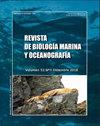Ciclo reproductivo de la ascidia Pyura chilensis (Urochordata:Ascidiacea) procedente de líneas de cultivo de mitílidos
IF 0.5
4区 生物学
Q4 MARINE & FRESHWATER BIOLOGY
引用次数: 2
Abstract
espanolLa ascidia solitaria Pyura chilensis, es considerada un recurso de importancia economica en el sector pesquero artesanal. Este organismo tiene una gran capacidad para colonizar sustratos artificiales, formando parte de la fauna incrustante en lineas de cultivo de ostreidos y moluscos, afectando la eficiencia de crecimiento de estos recursos. Por esta razon, es necesario conocer aspectos biologico - reproductivos de P. chilensis a fin de generar informacion para la futura implementacion de un plan de manejo, de conservacion o de cultivo de este recurso en la Region de Los Lagos, Chile. El objetivo de este estudio fue investigar el ciclo reproductivo y patrones de asentamiento de P. chilensis, analizando el indice de condicion e histologia gonadal de organismos procedentes de un sistema de cultivo de mitilidos ubicado en Estero Huito, Calbuco (41°43'S;73°09'W), durante 12 meses. Adicionalmente se analizo la preferencia de sustrato de larvas de P. chilensis, usando dos superficies artificiales. El Indice de condicion (masa corporal-distancia sifonal) mostro un aumento entre junio y septiembre, coincidiendo con un periodo de baja temperatura en primavera (organismos en estado IV); aun cuando la presencia de reclutas entre noviembre y junio estaria indicando posibles eventos de desove en otras estaciones. Se observo que entre el 40 y 100% de los organismos muestreados presentaron gonadas en estado II y/o III durante el periodo de estudio, lo cual sugiere una gametogenesis continua. El asentamiento larval fue mayor en sustrato rugoso obscuro (malla raschel) que en la superficie de plastico. Se concluye que en la zona de estudio es posible tener reclutamiento durante todo el ano con diferentes niveles de intensidad. Esta informacion permitiria planificar la ubicacion de colectores, para la captacion de reclutas en distintas epocas, generando una produccion continua de P. chilensis y disminuyendo la infestacion de otros sustratos. EnglishThe solitary sea squirt Pyura chilensis, is considered a resource of economic importance in the artisanal fisheries sector. This organism has a great capability to colonize artificial substrates, taking part in the encrusting fauna in long-line culture systems of ostreid and mussel, affecting the growth efficiency of these resources. For this reason, is necessary to know biological - reproductive aspects of P. chilensis in order to generate new information for future implementation of management plan, conservation and cultivation of this resource in the Region de Los Lagos, Chile. The purpose of this study was to investigate the reproductive cycle and settlement patterns of P. chilensis, analyzing the condition index and gonadal histology of organisms which come from a mussel farming system in Estero Huito, Calbuco (41°43'S;73°09'W) during 12 months. In addition, the settlement substrate preference of P. chilensis larvae was examined, using two artificial surfaces. The condition index (wet mass-siphonal distance) showed an increase between June and September, coinciding with low temperatures period and the spawning season (organisms in stage IV). However, recruit presence between November and June shows possible spawning events in other seasons. It was observed between 40 and 100% to gonadal stages II and/or III in the sampled organisms during the study period, which suggest a continuous gametogenesis. In addition, the larval settlement was higher in rough-dark substrate (raschel mesh) than in plastic surface. In conclusion, the study area may be recruiting throughout the year, but at different intensity levels. This information would allow planning the collectors location to attract the seasquirts recruits, generating a continuous production of P. chilensis and decreasing the infestation in others crops.来自有丝分裂培养系的智利海鞘(Urochordata:Ascidiacea)的繁殖周期
西班牙海鞘被认为是手工渔业部门的一种重要经济资源。这种生物具有很强的人工基质定植能力,是牡蛎和软体动物养殖线上附着动物的一部分,影响了这些资源的生长效率。出于这个原因,有必要了解辣椒的生物学和生殖方面,以便为未来在智利拉各斯地区实施该资源的管理、保护或种植计划提供信息。这项研究的目的是通过分析位于Calbuco Estero Huito(41°43's;73°09'w)12个月的杀螨剂培养系统中生物的性腺状况和组织学指数,研究辣椒的繁殖周期和定居模式。此外,还使用两个人工表面分析了辣椒幼虫对基质的偏好。条件指数(体重-虹吸距离)在6月至9月期间呈上升趋势,恰逢春季气温较低的时期(处于IV状态的生物);尽管11月至6月期间新兵的存在将表明其他季节可能发生产卵事件。值得注意的是,在研究期间,40%至100%的抽样生物的性腺处于II和/或III状态,这表明配子发生是持续的。在暗粗糙的基质(拉舍尔网)中,幼虫的沉降大于塑料表面。得出的结论是,在研究区,可以全年以不同的强度招募。这些信息将有助于规划收集器的位置,以便在不同时期招募新兵,产生持续的辣椒粉生产,并减少其他基质的感染。孤独的海水喷射器皮乌拉·奇伦西斯被认为是手工渔业部门的一种重要经济资源。该组织有很大的能力殖民人工基质,参与奥斯特雷德和麝香长期文化系统中的封闭动物,影响这些资源的增长效率。为此,有必要了解辣椒的生物学-生殖方面,以便为未来在智利拉各斯地区实施该资源的管理计划、保护和栽培提供新的信息。这项研究的目的是调查P.chilensis的生殖周期和定居模式,分析来自Calbuco Estero Huito(41°43's;73°09'w)一个麝香养殖系统的12个月内的条件指数和性腺组织。此外,还使用两种人工表面检查了辣椒幼虫的定居基质偏好。条件指数(湿质量-虹吸距离)在6月至9月期间有所增加,恰逢低温期和产卵季节(第四阶段的生物)。然而,11月至6月期间的招聘活动表明,在其他季节可能会举办繁殖活动。在研究期间,在样本组织中观察到40%至100%的性腺第二阶段和/或第三阶段,这表明存在持续的配子发生。此外,粗深色基质(拉舍尔网)中的幼虫沉降高于塑料表面。总之,研究领域可能全年都在招聘,但强度不同。这一信息将有助于规划收藏家的位置,以吸引SeaSquirts招聘人员,产生辣椒的持续生产,并减少其他作物的侵扰。
本文章由计算机程序翻译,如有差异,请以英文原文为准。
求助全文
约1分钟内获得全文
求助全文
来源期刊
CiteScore
0.70
自引率
0.00%
发文量
41
审稿时长
12 months
期刊介绍:
Publicar desde una perspectiva científica, artículos originales, decididos por un proceso de revisión por pares, invitando a expertos de reconocido prestigio en el área. Los trabajos publicados se caracterizarán por su solidez teórica-metodológica, actualidad y relevancia para las ciencias marinas.
Se reciben trabajos inéditos derivados de la investigación científica realizada en ambientes marinos y estuarios, en formato de Revisión, Artículos, Notas Científicas, y Obituarios en las siguientes disciplinas::
Biología-Ecología marina
Oceanografía física, química y biológica
Contaminación marina
Geología marina
Sistemática, Faunística y Biogeografía Marina
Manejo Costero
Acuicultura marina
Pesquería marina.

 求助内容:
求助内容: 应助结果提醒方式:
应助结果提醒方式:


